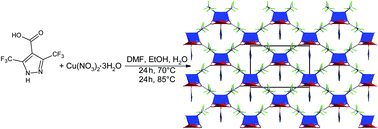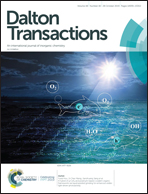CFA-15 – a perfluorinated metal–organic framework with linear 1-D CuII-chains containing accessible unsaturated, reactive metal centres†
Abstract
The synthesis and crystal structure of the perfluorinated metal–organic framework CFA-15 (Coordination Framework Augsburg University-15), CuII3(tfpc)2(OH)2·DMF, as well as the crystal structure of its ligand (H2-tfpc = 3,5-bis(trifluoromethyl)-1H-pyrazole-4-carboxylic acid) are described. The MOF crystallizes in the monoclinic crystal system within the chiral space group C2 (no. 5). It features a 3-D microporous framework with rhombic channels along the c-axis. The MOF is formed by 1-D chains of Cu(II) ions expanding in the c-direction, bridged by OH− groups, DMF molecules and tfpc2− ligands. Two different Cu(II) species are located within the structure, bridged in a {Cu1–Cu1–Cu2–Cu1–Cu1–Cu2} mode. By thermal treatment, it was possible to remove coordinated solvent molecules and generate free accessible, unsaturated and reactive metal centres. The structure of activated CFA-15 was refined via Rietveld method. DRIFT measurements, which were used to study adsorption of CO2 and NO in the MOF, showed a formation of a stable NO-CFA-15 complex. CFA-15 was further characterized by thermogravimetric analysis, variable temperature powder X-ray diffraction measurements, IR spectroscopy, as well as photoluminescence and gas sorption measurements. The isosteric heats of adsorption for CO, CO2, H2 and O2 were determined, and compared to DFT calculated sorption energies as well as to data reported in literature for similar materials.



 Please wait while we load your content...
Please wait while we load your content...